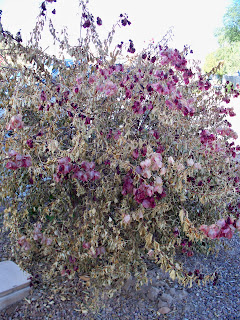Q. We have nine, 12-yr old butterfly irises is 3 groups of 3 that have outgrown their locations. They have grown/spread from their centers to become about 2 ft. in diameter and now only develop little new growth at their perimeters. I've attempted to prune them back by removing their dead center growth hoping that they will regrow from the center but to no avail. I'd like to replace them with some colorful, attractive ornamental grasses that do not grow taller than 3 ft. and don't spread like the irises.
A. I would keep the butterfly iris and just dig them this fall, divide them and replant them. Sometimes called Spuria or Spuria iris, these are some of the best iris for our desert climate and can be quite showy if managed properly. They must be divided regularly.
Some of the spurias originate out of Persia and Afghanistan. Many of these varieties like the high temperatures and dry humidities of the desert but not our infertile soils. They will perform best if they get some relief from late afternoon sun but should be in full sun most of the day.
They do not like rock mulch at all and should never be planted in rock mulch. Always use wood chips (not bark) mulch of two to three inches as a surface mulch to enrich the soil and keep it moist. They must be dug every three to four years and divided to perform well.
And they must be fed regularly as they are heavy feeders during the growing months. This can be done by applying regular fertilizers regularly or using slow release types less often. Fertilize during the bloom period with formulations of Osmocote, Peters or Miracle Gro for flowers.
Divide them with a sharp, sterile knife, cutting the rhizomes at a bud and allowing the rhizomes to heal for a couple of days. Or you can dust them with a fungicide after they are cut. Throw out any rhizomes that do not appear healthy or robust looking. Plant these divided rhizomes about two to three feet apart for solid stands in the future.
Since these iris (depending on the variety) can range in height up to four feet it is best if they are used toward the back of the planting area. When planting or replanting the soil should be reworked with about half compost by volume and add treble super phosphate to the planting mix if you want good bloomers.
A. I would keep the butterfly iris and just dig them this fall, divide them and replant them. Sometimes called Spuria or Spuria iris, these are some of the best iris for our desert climate and can be quite showy if managed properly. They must be divided regularly.
Some of the spurias originate out of Persia and Afghanistan. Many of these varieties like the high temperatures and dry humidities of the desert but not our infertile soils. They will perform best if they get some relief from late afternoon sun but should be in full sun most of the day.
They do not like rock mulch at all and should never be planted in rock mulch. Always use wood chips (not bark) mulch of two to three inches as a surface mulch to enrich the soil and keep it moist. They must be dug every three to four years and divided to perform well.
And they must be fed regularly as they are heavy feeders during the growing months. This can be done by applying regular fertilizers regularly or using slow release types less often. Fertilize during the bloom period with formulations of Osmocote, Peters or Miracle Gro for flowers.
Divide them with a sharp, sterile knife, cutting the rhizomes at a bud and allowing the rhizomes to heal for a couple of days. Or you can dust them with a fungicide after they are cut. Throw out any rhizomes that do not appear healthy or robust looking. Plant these divided rhizomes about two to three feet apart for solid stands in the future.
Since these iris (depending on the variety) can range in height up to four feet it is best if they are used toward the back of the planting area. When planting or replanting the soil should be reworked with about half compost by volume and add treble super phosphate to the planting mix if you want good bloomers.








